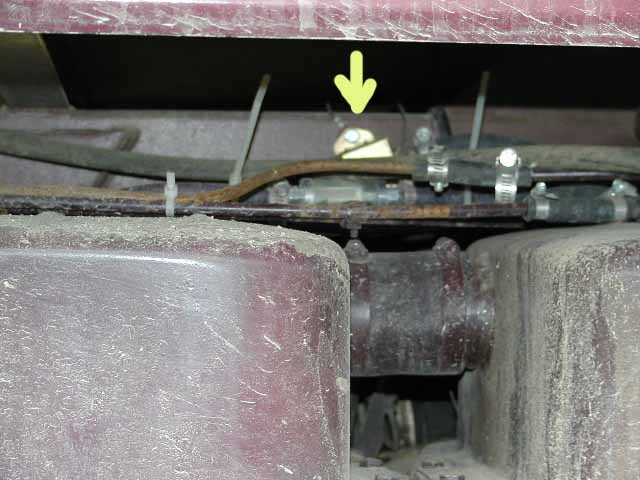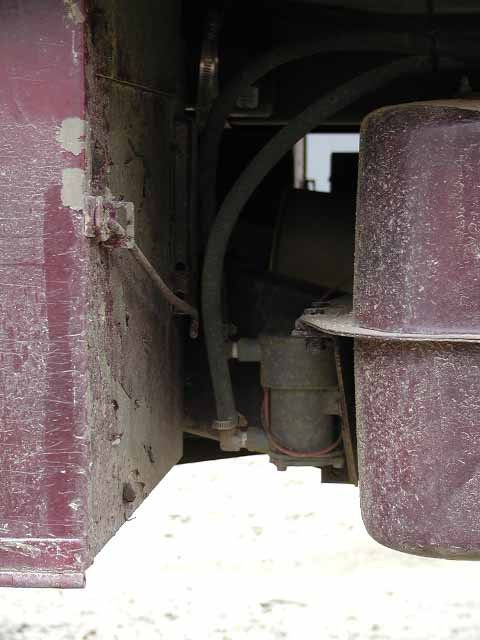Fuel Pump
When we got our UniMoG we also got some used spare parts to go with it. We chose parts based on our VW experiences as to what typically needs replacing on a 30-40 year old vehicle. This list included a spare water pump, coil, distributor, wheel (2nd spare), and a spare fuel pump. Having taken delivery of the MOG in the winter, we soon discovered how difficult it was to start in a Canadian winter, or so we thought.After much cold, cursing, and fuel, we discovered that the fuel pump was not pumping enough fuel for a cold weather start. It also turned out on an early spring trip that year that the spare was also not able to keep up. We feel that the fuel pump issue explains many of the complaints from many moggers. Our symptoms could be tested like this:
- Find a very long slight grade or headwind into which you can
drive in sixth gear at full throttle. Part throttle won't do
here.
- Note the maximum speed you attain.
- Keep going like this for a good five minutes or more. If
during that time your speed starts to slack off, then you may have
fuel delivery problems so proceed to the next step.
- Slightly ease off the throttle and see if you can get your
speed to pick up in the next few minutes.
Our solution was to put two 24V electric fuel pumps at the tanks and remove the stock pump. This decision was made because the price of a new Mercedes mechanical fuel pump and the new 24V pump were similar and the 24V pump has a much higher output than the mechanical. This did require the use of a fuel pressure regulator before the carb. The MOG now starts fine in the cold.
Our installation is somewhat unique due to the fact that we have three fuel tanks. To add to this complexity, we won't rely on just one fuel pump to get us out of the wilderness (bad past experiences), therefore we opted for two different brands of 24V fuel pumps. Each one is described below with part numbers for reference.

This picture shows the fuel pump for our third fuel tank which sits in the bed of the truck. The arrow points to the the Facet style fuel pump with is rubber mounted to the frame rail of the bed just above the stock fuel tanks. (P/N: 40164 - may be listed as Purolator or others, ours came from http://www.jnelectric.com). This is a common style of pump which contains very few moving parts, but it is much noisier than others when running. In fact, when it has no fuel in it, the pump vibration can be felt while seated in the cab! It is important to note that this pump is BELOW the tank which it pumps as electric pumps can push fuel well, but can't pull fuel.
Just below the fuel pump is an in line filter which is between the tank and the pump. There is also an inline filter just before the carburetor (a clogged jet can ruin your day). The large number of hoses and tubes is due to the fact that we have three tanks. Most 404s won't look this messy. We have also extended the vent line from the stock tanks all the way to the back of the truck because while running on the third tank, you get more venting and more smell from the two main tanks.

This picture shows the fuel pump for the two stock fuel tanks. It is a Stewart-Warner 24V diaphragm pump. (Ours came from Napa with a part # of 82054). It is solid mounted to the fuel tank mount below the center of the tank as per the manufacturers directions. This is important as our first one quickly overheated and died on it's first trip when mounted higher (again, electric fuel pumps push, they can't pull fuel - hence the reason we have two pumps). This pump has a built in filtration screen which is serviceable by three screws. This pump also runs quieter than the other pump once it has fuel. The two stock fuel tanks are T'd together such that the pump draws from them both. This was done so that we didn't need a third pump or to move the valve. Also, since we have a total range of 1600 km, the two stock tanks provide a reasonable reserve and there was no need to operate them as separate tanks.
Power to the pumps is provided through a switch on the dash. This allows three options of 'top tank', 'off', and 'bottom tank'. We also use a hand valve for selecting the tank. This is located in the stock tank selector position. This setup has been in place for over two years (20,000 km) and has given us no trouble. Unfortunately, we now have a lot of rubber fuel line, rather than the stock steel, which leaves us open to rodent nibbling, among other things.